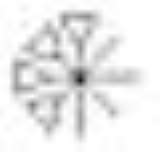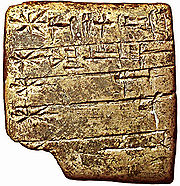
Dingir
Encyclopedia
Dingir is a cuneiform
sign, most commonly the determinative for "deity
" although it has related meanings as well. As a determinative
, it is not pronounced, and is conventionally transliterated
as a superscript "D" as in e.g. DInanna
. Generically, dingir can be translated as "god" or "goddess".
The sign in Sumerian cuneiform (DINGIR, DIGIR, ) by itself represents the Sumerian
) by itself represents the Sumerian
word an ("sky" or "heaven") or the ideogram for An
, the supreme deity of the Sumerian pantheon. In Assyrian cuneiform, it (AN, DINGIR, ) could be either an ideogram
) could be either an ideogram
for "deity" (ilum
) or a syllabogram for an, or ìl-. In Hittite
orthography, the syllabic value of the sign was again an.
The concept of "divinity" in Sumerian is closely associated with the heavens, as is evident from the fact that the cuneiform sign doubles as the ideogram for "sky", and that its original shape is the picture of a star. The original association of "divinity" is thus with "bright" or "shining" hierophanies in the sky. A possible loan relation
of Sumerian dingir with Turkic tengri
"sky, sky god" has been suggested.

 The Sumerian
The Sumerian
sign DINGIR originated as a star-shaped ideogram indicating a god in general, or the Sumerian god An
originated as a star-shaped ideogram indicating a god in general, or the Sumerian god An
, the supreme father of the gods. Dingir also meant sky or heaven in contrast with ki
which meant earth. Its emesal pronunciation was dimer.
The plural of dingir is dingir dingir.

 The Assyrian sign DINGIR could mean:
The Assyrian sign DINGIR could mean:
According to one interpretation, DINGIR could also refer to a priest or priestess although there are other Akkadian words ēnu and ēntu that are also translated priest and priestess. For example, nin-dingir (lady divine) meant a priestess who received foodstuffs at the temple of Enki in the city of Eridu.
(as of version 5.0) under its name AN at U+1202D .
Cuneiform script
Cuneiform script )) is one of the earliest known forms of written expression. Emerging in Sumer around the 30th century BC, with predecessors reaching into the late 4th millennium , cuneiform writing began as a system of pictographs...
sign, most commonly the determinative for "deity
Deity
A deity is a recognized preternatural or supernatural immortal being, who may be thought of as holy, divine, or sacred, held in high regard, and respected by believers....
" although it has related meanings as well. As a determinative
Determinative
A determinative, also known as a taxogram or semagram, is an ideogram used to mark semantic categories of words in logographic scripts which helps to disambiguate interpretation. They have no direct counterpart in spoken language, though they may derive historically from glyphs for real words, and...
, it is not pronounced, and is conventionally transliterated
Transliteration
Transliteration is a subset of the science of hermeneutics. It is a form of translation, and is the practice of converting a text from one script into another...
as a superscript "D" as in e.g. DInanna
Inanna
Inanna, also spelled Inana is the Sumerian goddess of sexual love, fertility, and warfare....
. Generically, dingir can be translated as "god" or "goddess".
The sign in Sumerian cuneiform (DINGIR, DIGIR,
 ) by itself represents the Sumerian
) by itself represents the SumerianSumerian language
Sumerian is the language of ancient Sumer, which was spoken in southern Mesopotamia since at least the 4th millennium BC. During the 3rd millennium BC, there developed a very intimate cultural symbiosis between the Sumerians and the Akkadians, which included widespread bilingualism...
word an ("sky" or "heaven") or the ideogram for An
Anu
In Sumerian mythology, Anu was a sky-god, the god of heaven, lord of constellations, king of gods, Consort of Antu, spirits and demons, and dwelt in the highest heavenly regions. It was believed that he had the power to judge those who had committed crimes, and that he had created the stars as...
, the supreme deity of the Sumerian pantheon. In Assyrian cuneiform, it (AN, DINGIR,
 ) could be either an ideogram
) could be either an ideogramIdeogram
An ideogram or ideograph is a graphic symbol that represents an idea or concept. Some ideograms are comprehensible only by familiarity with prior convention; others convey their meaning through pictorial resemblance to a physical object, and thus may also be referred to as pictograms.Examples of...
for "deity" (ilum
El (god)
is a Northwest Semitic word meaning "deity", cognate to Akkadian and then to Hebrew : Eli and Arabic )....
) or a syllabogram for an, or ìl-. In Hittite
Hittite language
Hittite is the extinct language once spoken by the Hittites, a people who created an empire centred on Hattusa in north-central Anatolia...
orthography, the syllabic value of the sign was again an.
The concept of "divinity" in Sumerian is closely associated with the heavens, as is evident from the fact that the cuneiform sign doubles as the ideogram for "sky", and that its original shape is the picture of a star. The original association of "divinity" is thus with "bright" or "shining" hierophanies in the sky. A possible loan relation
Loanword
A loanword is a word borrowed from a donor language and incorporated into a recipient language. By contrast, a calque or loan translation is a related concept where the meaning or idiom is borrowed rather than the lexical item itself. The word loanword is itself a calque of the German Lehnwort,...
of Sumerian dingir with Turkic tengri
Tengri
Tengri or Tengger Tengri or Tengger Tengri or Tengger (Old Turkic: ; Mongolian: Тэнгэр, Tenger; Chinese: 腾格里, Mandarin: Ténggélǐ, Hungarian: Tengri, Turkish: Tanrı, Bulgarian: Tangra (Тангра) is a sky god, formerly the chief deity of the early Turkic peoples, including the Xiongnu, Huns, Bulgars,...
"sky, sky god" has been suggested.
Cuneiform sign

Sumerian

Cuneiform script
Cuneiform script )) is one of the earliest known forms of written expression. Emerging in Sumer around the 30th century BC, with predecessors reaching into the late 4th millennium , cuneiform writing began as a system of pictographs...
sign DINGIR
 originated as a star-shaped ideogram indicating a god in general, or the Sumerian god An
originated as a star-shaped ideogram indicating a god in general, or the Sumerian god AnAnu
In Sumerian mythology, Anu was a sky-god, the god of heaven, lord of constellations, king of gods, Consort of Antu, spirits and demons, and dwelt in the highest heavenly regions. It was believed that he had the power to judge those who had committed crimes, and that he had created the stars as...
, the supreme father of the gods. Dingir also meant sky or heaven in contrast with ki
Ninhursag
In Sumerian mythology, Ninhursag or Ninkharsag was the earth and mother goddess, one of the seven great deities of Sumer. She is principally a fertility goddess. Temple hymn sources identify her as the 'true and great lady of heaven' and kings of Sumer were 'nourished by Ninhursag's milk'...
which meant earth. Its emesal pronunciation was dimer.
The plural of dingir is dingir dingir.


Assyrian

- the Akkadian nominal stem il-Ilahis an Arabic term meaning "deity" or "god". The feminine is ; with the article, it appears as . It appears in the name of the monotheistic god of Islam as , translated, that is, "the god"...
meaning "god" or "goddess", derived acrophonically from the Semitic ʾil-Ilahis an Arabic term meaning "deity" or "god". The feminine is ; with the article, it appears as . It appears in the name of the monotheistic god of Islam as , translated, that is, "the god"... - the god Anum
- the Akkadian word šamû meaning "sky"
- the syllables an and il
- a preposition meaning "at" or "to"
- a determinativeDeterminativeA determinative, also known as a taxogram or semagram, is an ideogram used to mark semantic categories of words in logographic scripts which helps to disambiguate interpretation. They have no direct counterpart in spoken language, though they may derive historically from glyphs for real words, and...
indicating that the following word is the name of a god
According to one interpretation, DINGIR could also refer to a priest or priestess although there are other Akkadian words ēnu and ēntu that are also translated priest and priestess. For example, nin-dingir (lady divine) meant a priestess who received foodstuffs at the temple of Enki in the city of Eridu.
Digital encoding
The cuneiform sign is encoded in UnicodeUnicode
Unicode is a computing industry standard for the consistent encoding, representation and handling of text expressed in most of the world's writing systems...
(as of version 5.0) under its name AN at U+1202D .
See also
- Religions of the Ancient Near EastReligions of the Ancient Near EastThe religions of the ancient Near East were mostly polytheistic, with some early examples of primitive monolatry , Ashurism and Monism...
- Mesopotamian mythology
- Sumerian languageSumerian languageSumerian is the language of ancient Sumer, which was spoken in southern Mesopotamia since at least the 4th millennium BC. During the 3rd millennium BC, there developed a very intimate cultural symbiosis between the Sumerians and the Akkadians, which included widespread bilingualism...
- Akkadian languageAkkadian languageAkkadian is an extinct Semitic language that was spoken in ancient Mesopotamia. The earliest attested Semitic language, it used the cuneiform writing system derived ultimately from ancient Sumerian, an unrelated language isolate...
- Hittite languageHittite languageHittite is the extinct language once spoken by the Hittites, a people who created an empire centred on Hattusa in north-central Anatolia...
- Eblaite languageEblaite languageEblaite is an extinct Semitic language, which was spoken in the 3rd millennium BC in the ancient city of Ebla, at Tell Mardikh , between Aleppo and Hama, in western modern Syria....

